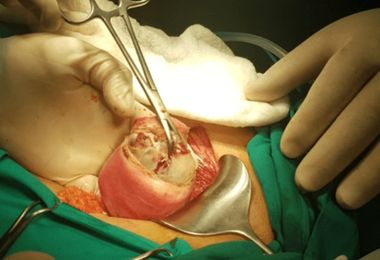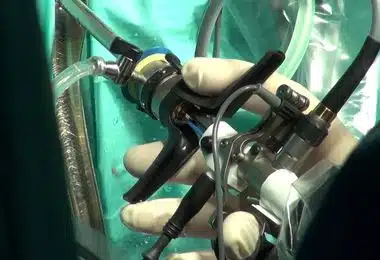
What Are Fibroids (Uterine Fibroids)?
November 15, 2022
What Is Hysteroscopy?
November 15, 2022
What Are Fibroids (Uterine Fibroids)?
November 15, 2022
What Is Hysteroscopy?
November 15, 2022
What is Bartholin’s Gland Cyst?
The Bartholin's Glands Cyst are two secretory glands located on both sides of the vagina in the thickness of the labia majora. They secrete a mucous secret that provides normal vaginal moisture, as well as lubrication during sexual intercourse.
How Does A Bartholin's Gland Cyst Form?
If the secreted secret, which provides normal vaginal moisture and lubrication during sexual intercourse, for some reason cannot fully flow to the vagina, it begins to accumulate in the Bartholin glands. Although this accumulation is not felt at first and does not cause any complaints, but over time, accumulating in the Bartholin glands more and more, it begins to cause their swelling, which is called a cyst of the Bartholin glands.

Image-1: Schematic drawing of the Bartholin gland cyst.
The reasons for the blockage of the ducts of the Bartholin glands and the accumulation of secretions there can be injuries, surgical procedures carried out in the past, infections, as well as edema and mucus discharge that occur due to them. According to experts, about 2-3 women out of 100 suffer from Bartholin’s gland cysts (Image-1).
What Is A Bartholin's Gland Abscess?
With the development of a cyst of the Bartholin gland, pathogenic flora penetrates it and begins to multiply. But sometimes, the opposite process occurs-first the appearance of pathogenic flora (infection), and only then, as a consequence, the formation of a cyst. In this case, we are talking about the appearance of a cyst after infection and an abscess of the Bartholin gland.
Can Cancer of the Bartholin's Gland Develop?
Cyst and abscess of the Bartholin gland usually refer to diseases of fertile (reproductive) age. It should be borne in mind that with the appearance of a cyst of the Bartholin gland after menopause, cancer may develop. Although this is not a general rule, painful and symptomatic Bartholin’s gland cysts in childbearing age indicate an abscess, while painless and asymptomatic cysts seen after menopause may indicate a possible development of cancer. If left untreated, Bartholin cysts and abscesses can cause various complications, such as the development of serious infections affecting the entire body (sepsis) and even the appearance of a rectovaginal fistula, which usually progresses into the intestine and leads to the ingestion of intestinal contents into the vagina.
What Are the Symptoms of Bartholin's Gland Cyst?
Symptoms of Bartholin’s gland cyst are the appearance of edema at the entrance to the vagina. Sometimes, before the onset of edema, there may be a feeling of pain during sexual intercourse. If the cyst of the Bartholin gland has passed into an abscess, then redness and a local increase in temperature will also be observed. In some patients, complaints and swelling may increase in the moments before and after each sexual act, as well as a decrease in volume during periods of lack of contact.
How Is Bartholin's Gland Cyst Diagnosed?
During gynecological examinations of patients who complain of swelling in the genital area, pain during sexual intercourse, redness, soreness, and fever, the diagnosis of a Bartholin’s cyst is made when a tumor is detected in the locations of the Bartholin’s gland (which approximately coincides with the 5 and 7 hours of the dial). Hypersensitivity with redness and fever indicates the presence of an infection, which indicates the presence of an abscess. As a rule, a gynecological examination is sufficient to diagnose a Bartholin’s cyst, and ultrasound or magnetic resonance imaging is not required. However, in the later stages or with complex complications such as sepsis or rectovaginal fistula, additional examinations and tests (radiography of the fistula or MRI with contrast) may be required.
How Is the Bartholin's Gland Cyst Treatment Done?
There are many treatment options for Bartholin’s gland cysts. Some of them are simple, but at the same time have a high risk of relapse, while others, being complex in execution, have better effectiveness in the long run.
Bartholin's Cyst Incision: This is a simple procedure performed under local anesthesia, in which the swollen part of the cyst is cut, allowing the contents of the cyst to be removed. After removing the contents of the cyst, it is washed from the inside, and the operation is stopped. Excision of the cyst is a procedure that provides only temporary relief. After overgrowth of the cut part, the contents of the cyst again begin to accumulate, and after a while, the question arises about the need to repeat this procedure.
Bartholin’s gland cyst marsupialization: During marsupialization, the cyst is opened by dissection at the site of the largest bulge of the cyst. Next, the contents are removed, and the subsequent cleaning of the cavity. Then the wall of the cystic formation is sewn to the edge of the labial mucosa, thereby leaving an artificially formed duct. Thanks to this procedure, the secret produced by the Bartholin gland begins to flow from the cyst directly into the vagina. Due to the successful prevention of the accumulation of secretions, this procedure is the most preferred one. Recovery from it takes several weeks.
Bartholin’s gland cyst treatment with the installation of a word-catheter: This treatment option for Bartholin’s cyst is relatively less popular. In it, as well as in marsupialization, the contents are removed, and the subsequent cleaning of the cavity. Then a catheter is placed there and fixed so that one end is inside the cyst and the other end is in the vagina. It is expected that after a few weeks, a channel will appear in the place of the catheter, which will no longer overgrow, and after this time, the catheter is removed. This method is used quite rarely, and the risk of its recurrence is close to the marsupialization procedure.
Bartholin’s Gland Cyst Removal
Complete removal of the Bartholin gland cyst is not a priority treatment method. Because after the removal of the cyst, the secretion of mucous secretions that provide normal vaginal moisture, as well as lubrication during sexual intercourse, will stop (due to the removal of the Bartholin gland itself). If the Bartholin gland of the opposite side is not damaged, problems with hydration usually do not occur, but even in this case, this method cannot be called preferable. This is rather a treatment option for recurrent cysts, not a treatment for the first case of the appearance of a Bartholin cyst. This operation can be performed under local and regional anesthesia, as well as under general anesthesia. The incision is made from the inside of the most swollen part of the cyst so that it is not visible from the outside. The cyst of the Bartholin gland is carefully separated from the surrounding tissues. After removing the cyst, the cavity formed in this area is carefully closed, to avoid problems such as bleeding, infection, etc. After that, the very first incised area of the vagina is sewn up. The recovery time after surgery is shorter than with the treatments described above (excision, marsupialization, catheterization). There is no risk of relapse with this treatment since the Bartholin gland is completely removed.
Bartholin's Gland Cyst Chemical Treatment
It is a less widespread method of treatment in which chemicals such as alcohol and silver nitrate are injected into a cyst that has been cleared of secretions, followed by the removal of the damaged cyst wall. This short-term procedure is performed under local anesthesia.

